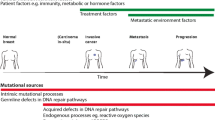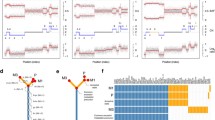Abstract
Background
Metastatic breast cancer is an aggressive disease associated with recurrence and decreased survival. To improve outcomes and develop more effective treatment strategies for patients with breast cancer, it is important to understand the molecular mechanisms underlying metastasis.
Methods
We used allelic imbalance (AI) to determine the molecular heritage of primary breast tumors and corresponding metastases to the axillary lymph nodes. Paraffin-embedded samples from primary breast tumors and matched metastases (n = 146) were collected from 26 patients with node-positive breast cancer involving multiple axillary nodes. Hierarchical clustering was used to assess overall differences in the patterns of AI, and phylogenetic analysis inferred the molecular heritage of axillary lymph node metastases.
Results
Overall frequencies of AI were significantly higher (P < 0.01) in primary breast tumors (23%) than in lymph node metastases (15%), and there was a high degree of discordance in patterns of AI between primary breast carcinomas and the metastases. Metastatic tumors in the axillary nodes showed different patterns of chromosomal changes, suggesting that multiple molecular mechanisms may govern the process of metastasis in individual patients. Some metastases progressed with few genomic alterations, while others harbored many chromosomal alterations present in the primary tumor.
Conclusions
The extent of genomic heterogeneity in axillary lymph node metastases differs markedly among individual patients. Genomic diversity may be associated with response to adjuvant therapy, recurrence, and survival, and thus may be important in improving clinical management of breast cancer patients.



Similar content being viewed by others
References
Eifel P, Axelson JA, Costa J, et al. National Institutes of Health consensus development conference statement: adjuvant therapy for breast cancer, November 1-3, 2000. J Natl Cancer Inst 2001;93:979–89
Ries LAG, Melbert D, Krapcho M, et al. (eds). (2007) SEER Cancer Statistics Review, 1975–2004. National Cancer Institute, Bethesda, MD. Available: http://www.seer.cancer.gov/csr/1975_2004
Weigelt B, Peterse JL, van’t Veer LJ. Breast cancer metastasis: markers and models. Nat Rev Cancer 2005;5:591–602
Fidler IJ, Kripke ML. Metastasis results from preexisting variant cells within a malignant tumor. Science 1977;197:893–5
Fearon ER, Vogelstein B. A genetic model for colorectal tumorigenesis. Cell 1990;61:759–67
Bernards R, Weinberg RA. Metastasis genes: a progression puzzle. Nature 2002;418:823
Schmidt-Kittler O, Ragg T, Daskalakis A, et al. From latent disseminated cells to overt metastasis: genetic analysis of systemic breast cancer progression. Proc Natl Acad Sci U S A 2003;100:7737–42
Goldhirsch A, Glick JH, Gelber RD, et al. Meeting highlights: international expert consensus on the primary therapy of early breast cancer 2005. Ann Oncol 2005;16:1569–83
Greene FL, Page DL, Fleming ID, et al. (eds). AJCC Cancer Staging Manual, Sixth Edition. Springer-Verlag, New York, 2002
Ellsworth DL, Shriver CD, Ellsworth RE, et al. Laser capture microdissection of paraffin-embedded tissues. BioTechniques 2003;34:42–6
Bertheau P, Plassa LF, Lerebours F, et al. Allelic loss detection in inflammatory breast cancer: improvement with laser microdissection. Lab Invest 2001;81:1397–402
Ellsworth RE, Ellsworth DL, Lubert SM, et al. High-throughput loss of heterozygosity mapping in 26 commonly deleted regions in breast cancer. Cancer Epidemiol Biomark Prev 2003;12:915–9
Medintz IL, Lee C-CR, Wong WW, et al. Loss of heterozygosity assay for molecular detection of cancer using energy-transfer primers and capillary array electrophoresis. Genome Res 2000;10:1211–8
Ellsworth RE, Ellsworth DL, Neatrour DM, et al. Allelic imbalance in primary breast carcinomas and metastatic tumors of the axillary lymph nodes. Mol Cancer Res 2005;3:71–7
Sneath PHA, Sokal RR. Numerical taxonomy. W.H. Freeman, San Francisco, 1973
Felsenstein J. PHYLIP: phylogeny inference package (version 3.63). Cladistics 1989; 5:164–6. Available: http://www.evolution.genetics.washington.edu/phylip.html
Camin JH, Sokal RR. A method for deducing branching sequences in phylogeny. Evolution 1965;19:311–26
Kluge AG, Farris JS. Quantitative phyletics and the evolution of Anurans. Syst Zool 1969;18:1–32
Felsenstein J. Confidence limits on phylogenies: an approach using the bootstrap. Evolution 1985;39:783–91
Gray JW. Evidence emerges for early metastasis and parallel evolution of primary and metastatic tumors. Cancer Cell 2003;4:4–6
Nishizaki T, DeVries S, Chew K, et al. Genetic alterations in primary breast cancers and their metastases: direct comparison using modified comparative genomic hybridization. Genes Chromosomes Cancer 1997;19:267–72
Hampl M, Hampl JA, Reiss G, et al. Loss of heterozygosity accumulation in primary breast carcinomas and additionally in corresponding distant metastases is associated with poor outcome. Clin Cancer Res 1999;5:1417–25
Kuukasjärvi T, Karhu R, Tanner M, et al. Genetic heterogeneity and clonal evolution underlying development of asynchronous metastasis in human breast cancer. Cancer Res 1997;57:1597–604
van’t Veer LJ, Dai H, van de Vijver MJ, et al. Gene expression profiling predicts clinical outcome of breast cancer. Nature 2002;415:530–6
Lähdesmäki H, Hao X, Sun B, et al. Distinguishing key biological pathways between primary breast cancers and their lymph node metastases by gene function-based clustering analysis. Int J Oncol 2004;24:1589–96
Al-Hajj M, Wicha MS, Benito-Hernandez A, et al. Prospective identification of tumorigenic breast cancer cells. Proc Natl Acad Sci U S A 2003;100:3983–8
Holmgren L, O’Reilly MS, Folkman J. Dormancy of micrometastases: balanced proliferation and apoptosis in the presence of angiogenesis suppression. Nat Med 1995;1:149–53
Klein CA, Hölzel D. Systemic cancer progression and tumor dormancy: mathematical models meet single cell genomics. Cell Cycle 2006;5:1788–98
Demicheli R, Miceli R, Moliterni A, et al. Breast cancer recurrence dynamics following adjuvant CMF is consistent with tumor dormancy and mastectomy-driven acceleration of the metastatic process. Ann Oncol 2005;16:1449–57
Luzzi KJ, MacDonald IC, Schmidt EE, et al. Multistep nature of metastatic inefficiency: dormancy of solitary cells after successful extravasation and limited survival of early micrometastases. Am J Pathol 1998;153:865–73
Guba M, Cernaianu G, Koehl G, et al. A primary tumor promotes dormancy of solitary tumor cells before inhibiting angiogenesis. Cancer Res 2001;61:5575–9
Fisher B, Gunduz N, Coyle J, et al. Presence of a growth-stimulating factor in serum following primary tumor removal in mice. Cancer Res 1989;49:1996–2001
Benson JR, della Rovere GQ. Axilla Management Consensus Group. Management of the axilla in women with breast cancer. Lancet Oncol 2007;8:331–48
Giuliano AE, Dale PS, Turner RR, et al. Improved axillary staging of breast cancer with sentinel lymphadenectomy. Ann Surg 1995;222:394–401
Stockler M, Wilcken NRC, Ghersi D, et al. Systematic reviews of chemotherapy and endocrine therapy in metastatic breast cancer. Cancer Treat Rev 2000;26:151–68
Ragaz J, Jackson SM, Le N, et al. Adjuvant radiotherapy and chemotherapy in node-positive premenopausal women with breast cancer. N Engl J Med 1997;337:956–62
Overgaard M, Jensen M-B, Overgaard J, et al. Postoperative radiotherapy in high-risk postmenopausal breast-cancer patients given adjuvant tamoxifen: Danish Breast Cancer Cooperative Group DBCG 82c randomised trial. Lancet 1999;353:1641–8
Cavalli LR, Urban CA, Dai D, et al. Genetic and epigenetic alterations in sentinel lymph nodes metastatic lesions compared to their corresponding primary breast tumors. Cancer Genet Cytogenet 2003;146:33–40
Goodison S, Viars C, Urquidi V. Molecular cytogenetic analysis of a human breast metastasis model: identification of phenotype-specific chromosomal rearrangements. Cancer Genet Cytogenet 2005;156:37–48
Acknowledgements
Presented in part at the Society of Surgical Oncology’s 61st Annual Cancer Symposium, March 13–16, 2008, in Chicago, IL. This work was performed under the auspices of the Clinical Breast Care Project, a joint effort of many investigators and staff members whose contributions are gratefully acknowledged. We especially thank the program participants. Supported by the United States Department of Defense (Military Molecular Medicine Initiative MDA W81XWH-05-2-0075). The opinion and assertions contained herein are the private views of the authors and are not to be construed as official or as representing the views of the Department of the Army or the Department of Defense.
Author information
Authors and Affiliations
Corresponding author
Rights and permissions
About this article
Cite this article
Becker, T.E., Ellsworth, R.E., Deyarmin, B. et al. The Genomic Heritage of Lymph Node Metastases: Implications for Clinical Management of Patients with Breast Cancer. Ann Surg Oncol 15, 1056–1063 (2008). https://doi.org/10.1245/s10434-008-9815-3
Received:
Revised:
Accepted:
Published:
Issue Date:
DOI: https://doi.org/10.1245/s10434-008-9815-3




